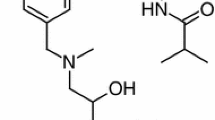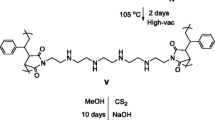Abstract
The poly([(2-methacryloyloxy)ethyl]trimethylammonium chloride) [P(MOTA)] based chelating resin was synthesized by radical polymerization and employed for Cr(VI) removal. The sorption capacity of this resin was very high with a fast sorption rate for Cr(VI) obeying a pseudo-second order kinetic model. In agreement to diffusion model equations, the rate determining step was film diffusion according to the infinite solution volume (ISV) model and reacted layer in accordance with the unreacted core (UC) model. In a column-mode sorption study, the breakthrough capacity obtained was 24.3 mg Cr/mL-resin. The elution of Cr(VI) from the resin was achieved using a mixture of 1.0 mol/L NaOH and 1.0 mol/L NaCl with an elution efficiency of about 100 %. Based on FT-IR measurements, it was clearly understood that Cr(VI) was sorbed by the resin through the quaternary amine functional groups.






Similar content being viewed by others
References
Rowbotham AL, Levy LS, Shuker LK (2000) Chromium in the environment: an evaluation of exposure of the UK general population and possible adverse health effects. J Toxicol Env Heal B 3:145–178
Rodrigues MLK, Formoso MLL (2005) Exposure to selected heavy metals through water ingestion in an area under the influence of tanneries. Environ Geochem Health 27:397–408
Chen TL, Wise SS, Holmes A, Shaffiey F, Wise JP, Thompson WD, Kraus S, Wise JP (2009) Cytotoxicity and genotoxicity of hexavalent chromium in human and North Atlantic right whale (Eubalaena glacialis) lung cells. Comp Biochem Phys C 150:487–494
Scarselli A, Binazzi A, Di Marzio D, Marinaccio A, Iavicoli S (2012) Hexavalent chromium compounds in the workplace: assessing the extent and magnitude of occupational exposure in Italy. J Occup Environ Hyg 9:398–407
Coudray C, Faure P, Rachidi S, Jeunet A, Richard MJ, Roussel AM, Favier A (1992) Hydroxyl radical formation and lipid-peroxidation enhancement by chromium—invitro study. Biol Trace Elem Res 32:161–170
Manygoats KR, Yazzie M, Stearns DM (2002) Ultrastructural damage in chromium picolinate-treated cells: a TEM study. J Biol Inorg Chem 7:791–798
Levina A, Lay PA (2008) Chemical properties and toxicity of chromium(III) nutritional supplements. Chem Res Toxicol 21:563–571
Paustenbach DJ, Hays SM, Brien BA, Dodge DG, Kerger BD (1996) Observation of steady state in blood and urine following human ingestion of hexavalent chromium in drinking water. J Toxicol Env Heal 49:453–461
Kerger BD, Finley BL, Corbett GE, Dodge DG, Paustenbach DJ (1997) Ingestion of chromium(VI) in drinking water by human volunteers: absorption, distribution, and excretion of single and repeated doses. J Toxicol Env Heal 50:67–95
Cohen MD, Kargacin B, Klein CB, Costa M (1993) Mechanisms of chromium carcinogenicity and toxicity. Crit Rev Toxicol 23:255–281
Costa M (1997) Toxicity and carcinogenicity of Cr(VI) in animal models and humans. Crit Rev Toxicol 27:431–442
Patlolla AK, Barnes C, Hackett D, Tchounwou PB (2009) Potassium dichromate induced cytotoxicity, genotoxicity and oxidative stress in human liver carcinoma (HepG(2)) cells. Int J Environ Res Pub Health 6:643–653
Marouani N, Tebourbi O, Mokni M, Yacoubi MT, Sakly M, Benkhalifa M, Ben Rhouma K (2011) Embryotoxicity and fetotoxicity following intraperitoneal administrations of hexavalent chromium to pregnant rats. Zygote 19:228–234
Bagchi D, Bagchi M, Stohs SJ (2001) Chromium (VI)-induced oxidative stress, apoptotic cell death and modulation of p53 tumor suppressor gene. Mol Cell Biochem 222:149–158
Asatiani N, Sapojnikova N, Abuladze M, Kartvelishvili T, Kulikova N, Kiziria E, Namchevadze E, Holman HY (2004) Effects of Cr(VI) long-term and low-dose action on mammalian antioxidant enzymes (an in vitro study). J Inor Biochem 98:490–496
Asatiani N, Abuladze M, Kartvelishvili T, Kulikova N, Asanishvili L, Holman HY, Sapojnikova N (2010) Response of antioxidant defense system to chromium (VI)-induced cytotoxicity in human diploid cells. Biometals 23:161–172
Dartsch PC, Hildenbrand S, Kimmel R, Schmahl FW (1998) Investigations on the nephrotoxicity and hepatotoxicity of trivalent and hexavalent chromium compounds. Int Arch Occ Env Hea 71:S40–S45
Bradberry SM, Vale JA (1999) Therapeutic review: is ascorbic acid of value in chromium poisoning and chromium dermatitis? J Toxicol-Clin Toxic 37:195–200
Davidson T, Kluz T, Burns F, Rossman T, Zhang QW, Uddin A, Nadas A, Costa M (2004) Exposure to chromium(VI) in the drinking water increases susceptibility to UV-induced skin tumors in hairless mice. Toxicol Appl Pharm 196:431–437
Joseph P, He Q, Umbright C (2008) Heme-oxygenase 1 gene expression is a marker for hexavalent chromium-induced stress and toxicity in human dermal fibroblasts. Toxicol Sci 103:325–334
Saha R, Nandi R, Saha B (2011) Sources and toxicity of hexavalent chromium. J Coord Chem 64:1782–1806
Arakawa H, Weng M, Chen W, Tang M (2012) Chromium (VI) induces both bulky DNA adducts and oxidative DNA damage at adenines and guanines in the p53 gene of human lung cells. Carcinogenesis 33:1993–2000
Urbano AM, Ferreira LMR, Alpoim MC (2012) Molecular and cellular mechanisms of hexavalent chromium-induced lung cancer: an updated perspective. Curr Drug Metab 13:284–305
WHO (2008) Guidelines for drinking-water quality. World Health Organization, Geneva
Demirbas A (2008) Heavy metal adsorption onto agro-based waste materials: a review. J Hazar Mat 157:220–229
Barrera-Diaz CE, Lugo-Lugo V, Bilyeu B (2012) A review of chemical, electrochemical and biological methods for aqueous Cr(VI) reduction. J Hazar Mat 223:1–12
Coetzer G, Giesekke EW, Guest RN (1997) Hexavalent chromium in the recovery of ferrochromium from slag. Can Metall Quar 36:261–268
Golder AK, Chanda AK, Samanta AN, Ray S (2007) Removal of Cr(VI) from aqueous solution: electrocoagulation vs chemical coagulation. Separ Sci Technol 42:2177–2193
Beyazit N (2014) Copper(II), chromium(VI) and nickel(II) removal from metal plating effluent by electrocoagulation. Int J Electrochem Sc 9:4315–4330
Agrawal A, Kumar V, Pandey BD (2006) Remediation options for the treatment of electroplating and leather tanning effluent containing chromium—a review. Miner Process Extr M 27:99–130
Wang G, Chang Q, Han X, Zhang M (2013) Removal of Cr(VI) from aqueous solution by flocculant with the capacity of reduction and chelation. J Hazard Mat 248:115–121
Sogancioglu M, Yel E (2014) Sludge using a marble processing wastewater treatment method. J Residuals Sci Tech 11:137–141
Aggarwal D, Goyal M, Bansal RC (1999) Adsorption of chromium by activated carbon from aqueous solution. Carbon 37:1989–1997
Mohan D, Pittman CU (2006) Activated carbons and low cost adsorbents for remediation of tri- and hexavalent chromium from water. J Hazard Mat 137:762–811
Kakavandi B, Kalantary RR, Farzadkia M, Mahvi AH, Esrafili A, Azari A, Yari AR, Javid AB (2014) Enhanced chromium (VI) removal using activated carbon modified by zero valent iron and silver bimetallic nanoparticles. J Env Health Sci Eng 12:115–224
Yalcin S, Apak R, Hizal J, Afsar H (2001) Recovery of copper (II) and chromium (III, VI) from electroplating-industry wastewater by ion exchange. Sep Sci Technol 36:2181–2196
Santander IP, Rivas BL, Urbano B, Leiton L, Ipek IY, Yuksel M, Kabay N, Bryjak M (2014) Removal of Cr(VI) by a chelating resin containing N-methyl-d-glucamine. Polym Bull 71:1813–1825
Rivas BL, Moreno-Villoslada I (1998) Poly[acrylamide-co-1-(2-hydroxyethyl)aziridine], an efficient water-soluble polymer for selective separation of metal ions. J Appl Polym Sci 69:817–824
Rivas BL, Schiappacasse N, Pereira E, Moreno-Villoslada I (2004) Interactions of polyelectrolytes bearing carboxylate and/or sulfonate groups with Cu(II) and Ni(II). Polymer 45:1771–1775
Lin Q, Wang Q, Duan Y, Wei X, Wu G, Luo Y, Xie Q (2013) Removal of Cu(II), Cr(III), and Cr(VI) from aqueous solution using a novel agricultural waste adsorbent. Sep Sci Technol 48:2843–2851
Dhal B, Das NN, Thatoi HN, Pandey BD (2013) Characterizing toxic Cr(VI) contamination in chromite mine overburden dump and its bacterial remediation. J Hazard Mat 260:141–149
Kotas J, Stasicka Z (2000) Chromium occurrence in the environment and methods of its speciation. Environ Pollut 107:263–283
Chowdhury P, Mondal P, Roy K (2010) Synthesis of cross-linked graft copolymer from [2-(methacryloyloxy)ethyl] trnimethylammonium and poly(vinyl alcohol) for removing chromium (VI) from aqueous solution. Polym Bull 64:351–362
Mustafa S, Ahmad T, Naeem A, Shah KH, Waseem M (2010) Kinetics of chromium ion removal from tannery wastes using Amberlite IRA-400 Cl− and its hybrids. Water Air Soil Pollut 210:43–50
Guo WS, Shim WG, Vigneswaran S, Ngo HH (2005) Effect of operating parameters in a submerged membrane adsorption hybrid system: experiments and mathematical modeling. J Membr Sci 247:65–74
Helfferich F (1962) Ion exchange. Dover Publications Inc., New York
Valipour M, Banihabib ME, Behbahani SMR (2013) Comparison of the ARMA, ARIMA, and the autoregressive artificial neural network models in forecasting the monthly inflow of Dez dam reservoir. J Hydrol 476:433–441
Valipour M (2014) Analysis of potential evapotranspiration using 11 modified temperature-based models. Int J Hydrol Sci Technol 4:192–207
Khasraghi MM, Sefidkouhi MAG, Valipour M (2015) Simulation of open- and closed-end border irrigation systems using SIRMOD. Arch Agron Soil Sci 61:929–941
Acknowledgments
The authors thank the so-called CHILTURPOL2 (PIRSESGA-2009 Project, Grant Number 269153) 7FP-MC Actions Grant. We also thank FONDECYT (Grant No. 1150510), REDOC (MINEDUC Project UCO1202 at University of Concepción) for the financial support.
Author information
Authors and Affiliations
Corresponding author
Rights and permissions
About this article
Cite this article
Santander, P., Morales, D., Rivas, B.L. et al. Removal of Cr(VI) from aqueous solution by a highly efficient chelating resin. Polym. Bull. 74, 2033–2044 (2017). https://doi.org/10.1007/s00289-016-1824-y
Received:
Revised:
Accepted:
Published:
Issue Date:
DOI: https://doi.org/10.1007/s00289-016-1824-y




